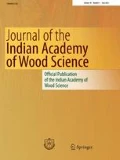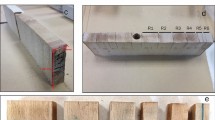Abstract
Timber as an important forest resource in the tropics has been processed to wood products in large quantity to fulfill an increasing need of both local and international consumers. To satisfy the increasing demand for the wood products, much of the timber has been supplied from fast-growing tree species grown on managed plantations (community forest, industrial plantation forest). The fast-growing wood species have been harvested in short age rotations and could contain higher proportions of juvenile wood. This research article discusses the occurrence and characteristics of juvenility in sengon (Paraserianthes falcataria) and jabon (Anthocephalus cadamba) woods based on density, bending strength (modulus of rupture (MOR), modulus of elasticity (MOE)), fiber length, and microfibril angle (MFA). Segmented modeling approach was used to find juvenile and mature transition, and the SAS non-linear procedure (PROC NLIN) was employed to identify the juvenile to mature transition ring. Fiber length and MFA appear to be the good anatomical indicators of ring demarcation between juvenile and mature wood, although maturation ring varies slightly between the fiber length and MFA. The use of ring density, MOR, and MOE were not appropriate, because of low coefficients of determination and large range of segmented rings for transition from juvenile to mature wood. The maturation rings were estimated to start at segmented rings 17 and 18 by the fiber length, 18 and 20 by the MFA for sengon and jabon respectively. The projected figures for the portion of juvenile wood both in sengon and jabon in the breast height stem at the age of 7 years were 100 %. As a result of this study, the consequent careful attentions should be given for the use of the jabon and sengon woods by some wood-processing technologies.








Similar content being viewed by others
References
Abdel-Gadir AY, Krahmer RL (1993) Estimating the age of demarcation of juvenile and mature wood in douglas-fir. Wood Fiber Sci 25(1993):242–249
Adamopoulos S, Passialis C, Voulgaridis E (2007) Strength properties of juvenile and mature wood in black locust (Robinia pseudoacacia). Wood Fiber Sci 39(2):241–249
Adamopoulos S, Karageorgos A, Passialis C, Chavenetidou M (2011) Mathematical approach for defining juvenile-mature wood transition zone in black locust and chestnut. Wood Fiber Sci 43(3):336–342
Biblis EJ (1990) Properties and grade yield of lumber from a 27-year-old slash pine plantation. For Prod J 40(3):21–24
Clark A, Richard F, Daniels Jordan L (2006) Juvenile mature wood transition in loblolly pine as defined by annual ring specific gravity, proportion of latewood, and microfibril angle. Wood Fiber Sci 38(2):292–299
Evans J, Senft JF, Green DW (2000) Juvenile wood effect in red alder: analysis of physical and mechanical data to delineate juvenile and mature wood zones. For Prod J 50:75–87
Gryc V, Vavrcik H, Horn K (2011) Density of juvenile and mature wood of selected coniferous species. J For Sci 57(3):123–130
Ishiguri F, Hiraiwa T, Iizuka K, Yokota S, Priadi D, Sumiasri N, Yoshizawa N (2009) Radial variation of anatomical characteristics in Paraserianthes falcataria planted in Indonesia. IAWA J 30:343–352
Johansson M, Kliger R (2002) Influence of material characteristics on warp in Norway spruce studs. Wood Fiber Sci 34(2):325–336
Kliger R (2001) Spiral grain on logs under bark reveals twist prone raw material. For Prod J 51(6):67–73
Koubaa A, Isabel N, Shu Yin Z, Beaulieu J, Bousquet J (2005) Transition from juvenile to mature wood in black spruce (Picea mariana (MILL.). Wood Fiber Sci 37(3):445–455
Kretschmann DE, Bendtsen BA (1992) Ultimate tensile stress and modulus of elasticity of fastgrown plantation loblolly pine lumber. Wood Fiber Sci 24(2):189–203
Krisnawati H, Varis E, Kallio M, Kanninen M (2011) Paraserianthes falcataria (L.) Nielsen: ecology, silviculture and productivity. CIFOR, Bogor
Larson PR, Kretschmann DE, Clark III A, Isebrands JG (2001) Formation and properties of juvenile wood in southern pines: a synopsis. Gen. Tech. Rep. FPL-GTR-129. Madison, WI: U.S. Department of Agriculture, Forest Service, Forest Products Laboratory, 42 p
MacPeak MD, Burkart LF, Weldon D (1990) Comparison of grade, yield, and mechanical properties of lumber produced from young fast-grown and older slow-grown planted slash pine. For Prod J 40(1):11–14
Martawijya A, Kartasujana I, Kadir K, Prawira S (2005) Atlas Kayu Indonesia. Forest Products Research Institute, Bogor
Mora CR, Lee Allen H, Daniels RF, Clark A (2007) Modeling corewood–outerwood transition in loblolly pine using wood specific gravity. Can J For Res 37:999–1011
Mutz R, Guilley E, Sauter UH, Nepveu G (2004) Modelling juvenile-mature wood transition in Scots pine (Pinus sylvestris L.) using nonlinear mixed-effects models. Ann For Sci 61:831–841
Panshin AJ, De Zeeuw C (1980) Textbook of wood technology: structure, identification, properties and uses of the commercial woods of the United States and Canada, 4th edn. McGraw-Hill, New York
SAS Institute (2004) SAS/STAT 9.1 User’s Guide, 1st edn. SAS Institute Inc., Cary, NC
Sauter UH, Mutz R, Munro D (1999) Determining juvenile-mature wood transition in scots pine using latewood density. Wood Fiber Sci 31(4):416–425
TAPPI (1991) Tappi test methods: Morphological characteristics of pulp fiber under microscope (T 401 om-88). Tappi, Atlanta
Tasissa G, Burkhart HE (1998) Juvenile-mature wood demarcations in loblolly pine trees. Wood Fiber Sci 30(1998):119–127
Zobel BJ (1984) The changing quality of the world wood supply. Wood Sci Technol 18:1–17
Acknowledgments
The authors thank the Directorate for Research and Community Service of the Ministry of National Education for the Republic of Indonesia for the research grant and RISTEK for the research mobility to France.
Author information
Authors and Affiliations
Corresponding author
Rights and permissions
About this article
Cite this article
Darmawan, W., Nandika, D., Rahayu, I. et al. Determination of juvenile and mature transition ring for fast growing sengon and jabon wood. J Indian Acad Wood Sci 10, 39–47 (2013). https://doi.org/10.1007/s13196-013-0091-x
Received:
Accepted:
Published:
Issue Date:
DOI: https://doi.org/10.1007/s13196-013-0091-x




